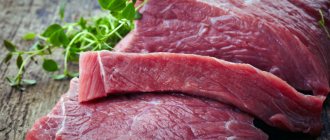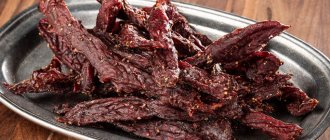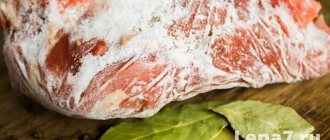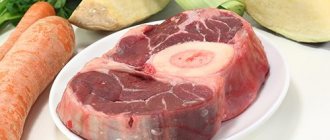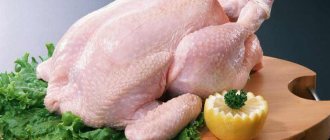Meat is a specific raw material. The characteristic features of meat are that it is a complete source of protein, has a multicomponent composition, heterogeneous structure, high biological activity and can change its characteristics when exposed to external factors.
In this regard, the production of high-quality meat products and the efficient use of raw materials are achieved through professionalism and compliance with the basic principles of production and meat storage technology.
Using refrigeration processing of meat, it can be divided into:
- Fresh meat, which is considered as such for 1.5 hours after the slaughter of the animal. The temperature in the depths of the muscle mass of such meat ranges from +25°C or more, differing slightly depending on the type of meat and part of the carcass. So, in the area of the hip part of the pork inside the muscles, the temperature of fresh meat should be at +35°C...+36°C, and for beef in the same part of the carcass (at a depth of at least 6 cm) the temperature is +36°C...+ 38°C.
- Chilled, obtained after cutting the carcass and brought using refrigeration units to a state where the temperature in the middle of the muscles is from 0 to + 4 ° C. Its surface has a small dried crust, and the muscle tissue itself is quite elastic.
- Frozen, which is subject to incomplete freezing: only the top layer is subject to it, no more than 25% of the total volume of the carcass. During transportation and storage of meat, frozen products, unlike chilled ones, are more stable and less susceptible to changes during heat treatment compared to frozen meat.
- Frozen meat is a product that has undergone freezing, as a result of which the temperature in the thickness of the muscles should not exceed -8°C. In addition to single types of mold, the development and growth of microorganisms in frozen meat is maximally inhibited, and therefore spoilage of frozen meat is eliminated.
In order to accumulate raw materials and short-term storage of meat with its simultaneous maturation, the meat is cooled, and for long-term storage of meat it is frozen. Cooling and freezing of meat is carried out in blast freezing chambers, refrigeration chambers, and low-temperature warehouses.
Preparing meat for storage
A decrease in the quality of meat, the emergence of difficulties in the technological processing of carcasses, as well as a decrease in the level of stability of meat during storage of chilled meat or frozen meat products largely depends on the primary processing of livestock, this is:
- method of slaughtering animals;
- bleeding process;
- whitening and skinning;
- scalding and hitting the bristles;
- sawing;
- wet and dry toilet.
Thus, for cattle, the mechanical stunning method is preferable to avoid internal hemorrhages and bone fractures. Compared to electrical stunning, such meat has significantly higher organoleptic (color, taste, smell) and technological (elasticity, water-binding capacity) parameters.
At the same time, it is better to stun pigs using a carbon dioxide gas mixture, the effect of which causes anesthesia in the animal, general immobility and relaxation of all muscles. This ensures productive bleeding and reduces the risk of internal hemorrhages.
Incomplete bleeding gives the meat a darker shade, as well as the likelihood of microbiological spoilage, both when storing fresh meat and chilled meat. Poor-quality whitening and skinning not only causes poor presentation due to cuts and snatches, but also allows mold and putrefactive microorganisms to penetrate into the meat, causing spoilage of the meat.
What happens to the product over time?
Meat is a perishable product. Therefore, at the first sign of spoilage of this product, it is strictly prohibited to eat it. There are many criteria that help determine the freshness of meat products. Three of them are the main and simplest:
- Appearance. Good meat has a dark brown or bright pink color. There should be no inclusions of other shades. The only exceptions are light fat layers. If the fat has acquired a gray or red color, this piece is already spoiled. The same applies to the color of bones/joints - in fresh meat they are always white, a different shade indicates spoilage of the product.
- Smell. Know that fresh and excellent quality meat has practically no smell; only a subtle milky smell may be present. If other flavors are present, it is better to avoid consuming meat.
- Consistency. A good meat product is elastic and dense to the touch. If, when pressing with a finger, a dent forms on the meat surface and does not disappear for a long time, the meat has spoiled. The same is true for the stickiness and slipperiness of a piece of meat.
In the following video you can see how to choose fresh meat:
Meat cooling methods
Even if the temperature decreases during post-mortem storage of meat, processes associated with fermentation, physical and chemical transformations in tissues continue to develop, which leads to changes in the water-binding capacity of meat, as well as its taste, smell, juiciness and consistency.
Cooling is the most common way to process fresh meat. To do this, after the initial processing, carcasses, half-carcasses or quarters are cooled hanging in freezers, for which meat hangers are used. Moreover, not only the temperature, but also the amount of air movement in different places of the chamber must be equal. To ensure that the load on the hanging tracks in the chamber does not exceed the norm, the most acceptable distance between carcasses should be from 3 to 5 cm.
Cooling of meat products in accordance with the rules for storing meat is carried out in several ways:
- In the refrigerating chamber while maintaining a constant temperature throughout the entire cooling period (temperature in the chamber is 0°C, air humidity is from 87% to 97%). The cooling time lasts from 30 to 36 hours, until the temperature inside the femur reaches +2°C ... +4°C).
- In a chamber with intensive cooling, where the process occurs faster due to lower air temperature (-8°C...-12°C), as well as increased air speed to 1-2m/s. This method allows you to cool the product several times faster: if the specified requirements are met, the temperature inside the thigh +3°C...+4°C is achieved in 6-8 hours. Since during intensive cooling there is a certain difference in the temperatures of the surface and internal layers of meat, it is sent for storage in a chamber maintaining a temperature of +2°C.
Based on the cooling time and level of meat drying, the following methods can be distinguished:
- Slow cooling, when this process occurs in refrigeration chambers at temperatures from 0°C to +3°C and air speed from 0.1m/s to 0.3m/s. The duration of cooling with this method takes from 24 to 36 hours, until the temperature in the thickness of the muscles drops to +3°C...+4°C. Moreover, shrinkage during wet cutting is 1.2% - 2.3%, and during dry cutting - 0.8% - 1.6%.
- Accelerated, which occurs at a temperature of about 0°C and an air speed of 0.5 m/s. With this method, the cooling time is reduced to 24 hours, and shrinkage is reduced to 1.5%.
- Rapid cooling is carried out in tunnel refrigeration chambers maintaining a temperature of -3°C and an air movement of 0.8 m/s. Cooling of meat to the required level is achieved in 13 hours (pork) and 16 hours (beef), and shrinkage is about 1.3%.
A slow decrease in temperature leads to the appearance of a characteristic dried crust on the carcass, which causes weight loss and reduces the functional and technological properties of the meat. Low intensity of cooling inside the muscle mass with inadequate sanitary treatment during the primary processing of pigs and livestock leads to an increase in the growth of putrefactive bacteria in the inner layers of meat, as well as to the appearance of a “tan” accompanied by an unpleasant pungent odor and unusual color.
What do GOSTs say?
According to government standards, the shelf life of meat at temperatures from -2 to +2°C is:
- 48 hours for pork, beef, poultry, lamb;
- 24 hours for ground beef or pork, marinated semi-finished products, offal;
- 12 hours for minced chicken.
GOST also states that meat requires air circulation of 0.2 m per second. Humidity should be between 85%.
According to GOST, after opening the package, it is advisable to consume the product within 12 hours.
This is interesting: How long can semi-finished meat products be stored? At what air temperature is it safe to store meat on the balcony in winter?
Methods for freezing meat and their features
Meat, like meat products, can be frozen by various methods: in air, salt solutions, boiling refrigerants, or in direct contact with metal plates of freezing units.
The most common method of freezing meat in air comes in the form of two methods:
- Single-phase, in which fresh meat is immediately frozen.
- Two-phase, when fresh meat is first cooled to a temperature of approximately +4°C, and then frozen at -8°C and below.
The most commonly used in industry is a two-phase method for freezing cattle, pork or lamb meat. Based on the freezing speed, they are divided into:
- Slow freezing, carried out at a temperature of -18°C...-23°C, air movement at a speed of 0.1m/s - 0.2m/s and humidity of about 90%-95%. This freezing lasts about 35-40 hours.
- Intensive, carried out at a temperature of -23°С...-30°С, air speed 0.5 m/s - 0.8 m/s and humidity 90%-95% for 28 hours.
- Fast, at which the air temperature is -30°C...-35°C, the air flow speed is from 1 to 4 m/s. Freezing meat using this method lasts about 18 hours.
Freezing of meat in production is carried out in a suspended state on overhead tracks, while the most voluminous parts (thighs) are placed on top, where air flow is maximum. The distance between carcasses, half-carcasses and quarters should be within 3 - 5 cm. Contact freezing, which is performed when interacting with a surface at low temperatures, can reduce the freezing time of meat by 1.5 - 2 times. With this method, meat blocks are placed between frozen metal plates located in special freezing equipment. In this case, boneless meat weighing 25 kg is frozen for 4-5 hours (at a temperature of -35°C, brought to -8°C inside the muscles).
How long does defrosted meat last in the refrigerator?
Thawed meat stays fresh for much less time. It is better not to keep it for more than 24 hours. This is due to the fact that the product was stored for some time before freezing.
The storage days begin to count after complete defrosting. In this case, you cannot use a microwave or hot water, as this disrupts the structure of the product and the beneficial substances are partially lost.
Types of cooking meat
To preserve meat and meat products, thermal processing methods can also be used:
- hot and cold smoking;
- baking, steaming, boiling and frying meat;
- drying (dehydration) of meat.
In this case, additional methods can be used to increase the preservative properties of products, such as:
- ambassador of raw materials;
- double cooking;
- high-temperature heating at increased osmotic pressure;
- a shift towards increased acidity of the pH indicator.
The shelf life of smoked meat is 72 hours, fried and boiled meat is 48 hours. It should be taken into account that additional cooling of meat that has undergone heat treatment to +3°C...+5°C increases several times.
Heat treatment of meat can be used both for intermediate short-term storage in the absence of refrigeration equipment, and for subsequent sale as finished products.
Optimal temperature
The average temperature in the refrigerator is +5°C, but it varies depending on the location and external conditions. Shelf life depending on temperature:
- +5…+7°C – up to 10 hours;
- 0…+5°C – up to 24 hours;
- -4…0°C – up to 48 hours.
This applies to fresh cuts of tenderloin. It is advisable not to store minced meat or chopped products after purchase. Such products are used immediately.
Meat shelf life
The production of chilled meat, which is in the ripening stage and has the highest nutritional properties in comparison with frozen meat, although it is economically profitable, has its drawback - a rather short shelf life.
The maximum shelf life of chilled meat in refrigerators and freezer cases, at temperatures from 0°C to -2°C, humidity from 85% to 90% and slight air circulation (about 0.1 m/s) are:
- beef – no more than 16 days;
- pork and lamb – no more than 12 days.
Frozen (temperature -2°С…-3°С) meat can be stored for up to 20 days.
When selling meat in the form of carcasses in retail outlets at a temperature of about 0°C, meat can be stored for up to 3 days.
Freezing meat is the most commonly used method for storage because it provides a high level of preservation and a long shelf life. Despite the disadvantages of this storage method (reduction in weight and quality, high material costs), it is the most effective way for long-term storage of meat and preservation of its taste and nutritional characteristics.
At a storage temperature of frozen meat within -12°C and humidity from 95% to 98%, its shelf life is:
- beef – 8 months;
- pork – 3 months;
- lamb – 6 months.
When maintaining a temperature of -18°C in the chamber, frozen meat is stored for at least:
- beef – 13 months;
- pork – 6 months;
- lamb – 10 months.
In chambers providing a temperature of -30°C, frozen meat can be stored:
- beef – up to 2 years;
- pork – up to 15 months;
- lamb – up to 2 years.
Rabbit carcasses frozen to a temperature of -9°C and below are stored for up to 6 months. In refrigerators, meat is stored in dense stacks or in pallets in several rows.
The shelf life of meat in stores where the temperature in refrigeration equipment is about 0°C is no more than 5 days, at temperatures from 0°C to +6°C - up to 3 days, at temperatures from +6°C to +8° C – up to 2 days.
How to store at home?
Many citizens like to stock up on meat for future use. But not everyone knows the timing and proper storage of such products.
How and for how long can you keep pork, beef and semi-finished meat products in the freezer?
Before storing meat for long-term storage, it needs to be prepared. Meat products are placed in places with the lowest temperature (it is recommended to activate the “Freeze” mode 4-5 hours before placing meat products there).
Reference. There is no need to rinse meat before storing it in the freezer - this procedure reduces shelf life.
The only thing that should be done is to sort through the meat product and cut off the fat from the muscle fibers (the fat layer is stored less and can spoil the main part). It is recommended to keep the meat in the refrigerator for 3-5 hours before placing it in the freezer. The colder the product, the better for freezing.
To save freezer space, cut large pieces of meat into several small ones. Before directly storing meat for freezing, it should be wrapped in parchment or cling film. Then the individual pieces are packaged in plastic bags (it is better to use sealed vacuum packaging).
The pieces should be placed tightly - this will help maintain a low temperature. Label each bag with the date it was frozen.
There are general storage periods for semi-finished meat products in a home freezer according to SanPin. This:
- pork and beef: up to a year;
- bird carcasses, game and rabbit meat: up to 7-8 months;
- goulash: up to 4-5 months;
- minced meat: 3-4 months;
- sausages: up to 2-3 months.
In the following video you can see how to properly prepare meat for storage in the freezer:
How long can defrosted food last in the refrigerator?
If, for technical reasons, frozen meat is defrosted in the refrigerator itself, it is recommended to store it for up to 24 hours during subsequent freezing. But remember that the longer such a product is stored, the more juice it loses.
Important! If meat has been defrosted at room temperature (or in the microwave), it can no longer be frozen. It should be prepared without delay, within the next 2 hours.
How long does it last without freezing?
If you decide to cook chilled meat products within the next 2 days, you can do without freezing during storage.
- Meat (beef and lamb) should be kept at a temperature range from 0⁰С to -3⁰С for 2 days.
- Fresh poultry lasts longer – up to 5 days.
- Raw pork also retains its quality longer; it can be stored for up to 4-5 days, and at -3⁰C for up to 3 weeks.
- Minced meat can be stored for 10-12 hours, other offal should be consumed within 6 hours of such storage.
Boneless meat lasts longer in the refrigerator, and the shelf life of whole pieces of meat increases.
To extend the storage period, you should use the following tips:
- store products in a food container with a tightly closed lid on the top shelf of the refrigerator;
- raw meat should be kept separate from other foods;
- It is undesirable to use plastic bags - the meat needs access to air;
- To extend storage time, it is recommended to treat meat pieces with vinegar (soak a natural cloth in vinegar and wrap the meat in it), this method helps to increase shelf life by 2-3 days.
How long does boiled and fried food last?
Reference. Boiled and fried pieces of meat can be stored for no more than 2 days in the refrigerator, in the freezer - up to a month.
But jellied meat can be stored for about a week without losing its taste and usefulness. But, if no salt was used in its production, the jellied meat can only be stored for up to 5 days.
Meat storage conditions
In addition to the temperature regime when storing meat, the following parameters must be observed:
- relative humidity, the value of which depends on the air temperature, but should not be lower than 85%;
- air flow circulation (must correspond to 4 to 6 air volumes per hour).
Also, when determining the terms and conditions for storing meat, one should take into account the presence or absence of packaging (vacuum, PVC film, paper, etc.), as well as the composition of the gas mixture or the use of inert gases. When storing chilled meat, free air access must be provided to it, so it should be suspended, without touching each other or the walls of the chamber.
Storing meat in a freezer at a strong temperature drop (down to -30°C...-50°C) can cause significant weight loss in the product, so in such cases an active air humidification system in the chamber is used.
SanPiN and GOST
Technologies for raising livestock are developing. The manufacturer sees it as inappropriate to send animals to pasture and fatten them for a year and a half, and therefore synthetic amino acids were introduced into the diet, which affect the growth rate and quality of meat.
GOST no longer establishes specific storage periods and conditions - it depends on the manufacturer. However, GOST regulates the recommended time, which is prohibited to exceed. Thus, the storage period of chilled beef, which was vacuum-packed at a temperature of -1...+4 ̊C and a humidity of about 85%, should not exceed 25 days from the moment of slaughter. This period includes the ripening period of the product, which is at least 5 days.
For each category of meat, as well as for beef, there are its own standards, which are regulated by GOSTs and SanPiN - they are shown in the table.
| Boneless meat products | ||||
| Large pieces: | Acceptable storage time | |||
| Packaged meat, as well as portioned semi-finished products (split; tenderloin; natural beefsteak; entrecote; rump steak; lamb, beef, pork, oven; schnitzel, escalope, etc.) without breading; | Up to two days | |||
| Portioned semi-finished products (rump steak, natural pork or lamb cutlet, schnitzel) breaded. | Up to one and a half days | |||
| Small-piece semi-finished products: | ||||
| Beef stroganoff, fried, azu, beef for stewing, meat for shish kebab, goulash, special roast, cold cuts (without sauces and spices); | Up to one and a half days | |||
| Marinated and with sauces | Until one day | |||
| Minced meat semi-finished products: | ||||
| Molded, stuffed, and also breaded (zucchini, peppers, cabbage rolls); | Up to one day | |||
| Combined: meat and vegetable cutlets, meat and cabbage cutlets, meat and potato cutlets, containing soy protein. | Until one day | |||
| Minced meat: pork, beef and other slaughtered livestock, combined: | ||||
| Made by meat processing plants; | Up to one day | |||
| Made in retail and catering establishments. | Up to 12 o'clock | |||
| Semi-finished meat and bone products (portioned, large-piece, small-piece). | Up to one and a half days | |||
| By-products of slaughtered animals (liver, tongue, kidneys, stomachs, heart, brains). | Up to one day | |||
| Semi-finished poultry meat products. | ||||
| Natural semi-finished poultry products: | ||||
| Meat-and-bone, boneless (no breading): carcass prepared for subsequent processing, hams, fillets, quarters, tobacco chickens, thighs, wings, drumsticks, breasts; | Up to two days | |||
| Meat-and-bone, boneless (breaded), with spices, with sauce, marinated. | Until one day | |||
| Semi-finished poultry meat products, minced, breaded or not. | Until 18:00 | |||
| Minced chicken. | Up to 12 o'clock | |||
| By-products, semi-finished products from by-products. | Up to one day | |||
| Sets for stews, jelly, soups. | Up to 12 o'clock | |||
| Ready-made meat products. | ||||
| Boiled meat: for cold dishes; in large pieces, cut into portions for soups and side dishes. | Until one day | |||
| Fried and stewed meats: roasted pork and beef for cold dishes; beef and pork fried in large pieces, cut into portions for soups and side dishes, stuffed meat. | Up to one and a half days | |||
| Fried minced meat dishes: steaks, cutlets, meatballs, schnitzels and others. | Up to one day | |||
| Pilaf, manti, dumplings, pancakes, belyashi, dumplings, pies. | Up to one day | |||
| Hamburger, sandwich ready, cheeseburger, pizza ready. | Until one day | |||
| Jelly meat dishes: jellied meat, jellied meat, brawn, jellied meat. | Up to 12 o'clock | |||
| Boiled meat by-products (udder, tongue, kidneys, heart, brains), fried. | Until one day | |||
| Liver and meat pates. | Up to one day | |||
| Chicken dishes. | ||||
| Smoked, smoked-baked and smoked-boiled carcasses and parts. | Up to three days | |||
| Ready-made poultry products, fried, boiled, stewed. | Up to two days | |||
| Products made from minced poultry meat, with garnish or sauces. | Up to 12 o'clock | |||
| Dumplings, poultry pies. | Until one day | |||
| Jelly products from poultry meat: jellies, brawns, jellied meats, as well as assorted meat products from slaughter animals. | Up to 12 o'clock | |||
| Poultry and offal pates | Up to one day | |||
| Boiled eggs | Up to one and a half days | |||
| Sausages from meat products of all types of poultry and slaughtered livestock. | ||||
| Boiled sausages produced in accordance with GOST: | ||||
| Highest and first category | Up to three days | |||
| Second category | Up to two days | |||
| Sausages cooked according to GOST in vapor-gas-tight films: | ||||
| Highest category, gourmet, containing preservatives | Up to 10 days | |||
| First category | Up to 8 days | |||
| Second category | Up to one week | |||
| Sausages, boiled sausages, meat loaves, produced in accordance with GOST. | Up to three days | |||
| Sausages, boiled sausages in vapor-gas-tight films. | Up to one week | |||
| Sausages, boiled wieners, sausages, sliced and vacuum packed in a modified atmosphere environment. | Up to 5 days | |||
| Boiled meat products (rolls, hams, pressed pork and beef, bacon, ham, pressed pork head meat, lamb in shape). | Up to three days | |||
| Boiled meat products, sliced and vacuum packed in a modified atmosphere environment. | Up to 5 days | |||
| Blood and liver sausages | Up to two days | |||
| Sausages, boiled sausages, sausages containing by-products. | Two days | |||
| Sausage products boiled from poultry meat (sausages, meat breads, frankfurters, rolls, ham, sausages, etc.) | ||||
| Highest category | Three days | |||
| First category | Two days | |||
| Sausage products cooked from poultry meat, vacuum packed in a modified atmosphere. | 5 days | |||
Increasing the shelf life of meat
To increase the shelf life of chilled meat, the following methods are used:
- storage in a carbon dioxide atmosphere;
- using nitrogen, ozone;
- substances are used that form a film on the surface of the meat;
- the use of antibiotics, ultraviolet radiation and radiation exposure.
The listed methods for increasing the shelf life of meat are not widely used in practice. In addition, to extend the shelf life of meat, some food acids can be used, which, in addition to bactericidal properties, improve the color of meat, its digestibility, and loosen the protein structure.
Vacuum packaging of meat extends the storage period by 2 times. Vacuum packaging is most widespread when storing chilled meat.
In conclusion, it should be noted some features that affect the quality and nutritional value of meat depending on the methods and conditions of its storage.
- Unlike frozen meat (especially that which has been quickly frozen), chilled meat has significantly greater nutritional value and increased taste. This is due to the fact that frozen meat is frozen at the stage of rigor mortis of the animal, without going through the maturation stage. Because of this, quickly frozen meat turns out to be tougher and less juicy during cooking.
- When storing frozen meat, a process of salting out a certain part of the protein occurs, which increases the concentration of salts in the muscles due to freezing of water, and the solubility of proteins is lost.
- By extending the shelf life of frozen meat, protein hydration decreases, which causes loss of meat juice during defrosting of meat.
- Meat stored at a temperature of -18°C for 2 years loses 2.5 times more juice during defrosting than meat stored for 4 months.
Raw meat without refrigeration
Sometimes situations arise when you need to save meat, but you don’t have access to a refrigerator. To extend the freshness of chilled meat for a couple of days without lowering the temperature, you can take the following measures:
- A strong solution of table salt - a large volume of the mineral dissolves in water. Moisten a cotton towel with the solution. The piece of meat is wrapped in paper and a wet towel on top of it.
- Rub the piece of meat with lemon juice or table vinegar and close it in a glass jar without a lid.
- The chilled piece of meat is wrapped in fresh nettle leaves and placed in a glass container, which is wrapped in a damp natural cloth (a cotton towel is suitable). Instead of glass containers, it is permissible to use enameled ones.
- Using chilled milk, the meat product is placed in a pan, and fresh milk is poured on top of it so that the liquid completely covers the piece.
Attention! Regardless of the method chosen, meat must be stored in a dark and cool place.
Another option to preserve meat without refrigeration is drying it. The whole piece of meat is washed well with warm water, the veins and fat are removed. Then the piece is wiped with paper napkins or towels. The recipe is as follows:
- cut the meat into cubes, approximately 1*1 cm;
- the chopped product is sprinkled with spices, chopped onions are added;
- put under oppression for one day;
- the cubes are laid out on a baking sheet in one layer, salted;
- dry in the oven at low power (up to 55 °C) for 10-12 hours.
When the dish is ready, it is dark in color and feels dry, elastic and tough to the touch.
Properly dried meat can remain usable for two months without refrigeration, provided it is kept in a tightly sealed container. Before use, this product must be boiled for 20 minutes.
It is permissible to preserve chilled meat, but it is important to follow the rules, since violating them can lead to a serious illness - botulism. Use a glass container whose volume does not exceed 1 liter. The jar is sterilized and then filled with fresh, boiled, stewed or baked meat, which is filled with sauce or water almost up to the neck, but with a distance of 2 cm from it. Close with a sterile lid. The jar is placed in water, which is brought to a boil; as the water evaporates, the liquid is added. The boiling time for the jar is one and a half hours. The next day it is advisable to repeat sterilization. If canned meat is kept at temperatures up to +10 °C, then sterilization is repeated after 3 months.
SanPiN 2.3.2.1078-01
Sanitary rules include hygienic requirements for the safety of food products, including meat and fish.
According to SanPiN 2.3.2.1078-01, animal meat, poultry and fish must:
- provide the human body with the substances necessary for its normal functioning;
- have the usual taste and smell.
The document reflects the maximum content of chemical pollutants and biological organisms that can harm human health.
In fresh, chilled and frozen meat, semi-finished products, the amount of toxic substances should not exceed, in mg/kg:
- lead – 0.5;
- arsenic – 0.1;
- cadmium – 0.05;
- mercury – 0.03.
According to the rules, parasitological control of meat and fish products is mandatory.
How to prepare meat, poultry or fish for freezing
How to properly prepare food for freezing:
- It is recommended not to wash the meat: water accelerates the decomposition processes in the tissues.
- It is better to divide the product into small pieces, since large pieces are more susceptible to spoilage.
- Soft tissue should be separated from the bone.
It is recommended to wrap it in a napkin soaked in vinegar.
The fish should be gutted, washed and removed excess moisture
It is not recommended to defrost meat in water (cold or hot); it is better if it thaws gradually in the refrigerator.
You cannot store it in the refrigerator on a wooden cutting board, which will quickly absorb the juice: the taste and nutritional qualities are lost.
The fish should be gutted, washed and excess moisture removed. We also recommend reading how to properly defrost fish.
How to determine the freshness of meat
Before going on sale, the product is thoroughly checked for compliance with legally established norms and standards by regulatory authorities. In this case, the animal carcass is butchered at the meat processing plant according to all the rules, after which it is thoroughly washed and cleaned.
Then veterinary and sanitary control is carried out, as a result of which the meat is either allowed for sale - then a stamp of a certain type is placed on it, or it is rejected. The final stage of pre-sale preparation of a product is obtaining a quality certificate.
This is what fresh lamb looks like
The seller seeks to attract the consumer's attention by offering a beautiful-looking product. The buyer's task is to determine the freshness of the meat by assessing it according to the following criteria:
Smell
The aroma emanating from a fresh product should not be repulsive. It should be fresh and natural, without any additional impurities or shades. If the piece has a beautiful appearance, but its aroma is unpleasant, then it is better to refuse such a purchase.
Color
The shade varies depending on the type:
- pork flesh is pink-red in color and has a delicate structure with slight inclusions of veins (marble pattern);
- high-quality beef is red in color, the fat layer is light and unclouded. If the meat is “stale”, then the cut will be dark red, almost brown;
- dairy veal is bright pink with flecks of fat;
- Lamb is valued for its nutritional value and naturalness. Fresh meat has a light red tint and is generously “stuffed” with white fat.
This is what beef fillet looks like
Consistency
The freshness of the product can be checked by pressing on the pulp with a special fork, which is available at every seller. If the meat has just gone on sale, the integrity of the surface will quickly be restored, but if it has been stored for a long time, the dent will remain for a long time. In addition, the piece may seem “dry” in appearance, but if you cut it, a clear liquid will flow from the cut of the fresh product.
If you buy meat in a supermarket, then you need to pay attention to the contents of the package. So, when a piece is beautifully presented in a plastic box, and streaks are visible at the bottom of the tray, then such a product is stale. Failure to comply with the storage conditions is indicated by pink ice crystals surrounding the frozen piece of meat. You should absolutely not buy, much less consume, a product whose flesh has acquired a grayish tint. The pink color of the fat may even be the result of “soaking” the meat in a manganese solution to give it a marketable appearance if the expiration date has expired.
In order to distinguish fresh pulp from previously frozen pulp when purchasing, you also need to simply press on its surface. The product, which has not previously been frozen, is distinguished by the fact that the place of pressure smoothes out very quickly. Thawed meat has a less elastic structure, which is why the hole lasts a long time and its filling with liquid indicates that the piece has already been in the freezer.
How to defrost correctly
To ensure that the meat retains its taste, it should not be defrosted using a microwave oven or hot water. The defrosting process takes time. It is best to do this in the refrigerator or cold water.
The refrigerator method is quite long, but it prevents the proliferation of pathogenic bacteria and ensures that the meat does not spoil.
It is important to consider the temperature in the refrigerator. The maximum permissible value is +5°C. When properly defrosted, meat should not smell bad or release large amounts of moisture.
The product is left in its original packaging or placed on a plate with a paper towel on the bottom. It is not recommended to defrost it in a regular bag, as the meat will “suffocate.”
The cold water option is faster. It takes 2-3 hours, but requires attention. Fill a container with cold water and place the meat in its original packaging into it. If the product is without it, it is tightly wrapped in film so that water and air do not penetrate inside. Otherwise, bacteria will begin to multiply quickly, and after cooking the meat will become very tough.
The water is changed every half hour. This is required to ensure that the temperature remains stable and the product defrosts evenly.
Correct actions when turning off the lights
If the power outage was short-lived (about 2 hours), nothing will happen to the meat. If there is no light for a long time, the product will deteriorate. To extend the shelf life, do not open the refrigerator doors again. This allows you to maintain a cold temperature longer.
The meat is transferred to a glass, plastic or enamel bowl and covered with a paper towel. After this they are sent to the freezer.
If there was a warning about an extended blackout, for example, a day or longer, such methods will not help preserve the product. In this case, the meat is cut into small pieces and dipped generously in salt. After this, they are placed in layers in a jar. Sprinkle each layer with about 1 cm of salt. The jar is sent to a cool place. Salting allows you to preserve the product for several weeks.
